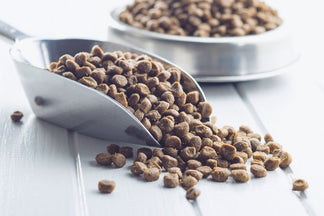The next ingredient in our ongoing series on Not So Healthy Ingredients for Your Pet is corn. Corn is a cereal grain and a staple at summer barbecues as well as in your pet’s food.
What is a corn?
Corn (or maize) is a cereal grain.
The corn you eat at that summer barbecue is quite different than the corn put into pet food. The corn you eat is called sweet corn, but the corn used in processing is called dent corn. It is not sweet, but is the processed corn you find in corn starch, high fructose corn syrup, corn cereal, livestock feed and pet food.
Why would corn be in pet food?
Corn does have some redeeming qualities. As a carbohydrate, corn provides energy as well as fiber, which aids in digestion, plus folate, thiamin, phosphorus, vitamin C, and magnesium (about 10% of the daily value for each).
Corn is also found in pet food because it is a readily available, starchy filler. Corn is also a highly subsidized crop with over 15 billion bushels harvested in the U.S. in 2016. The corn used in pet food grows fast, is resistant to pests due to genetic modification and it doesn’t even have to taste good. Corn is also an essential component to the kibble making process of gelatinization.
Are there any risks to feeding your pet corn?
Yes. In addition to the concerns about GMOs, corn is not easily digested by our pets – you can see evidence of that in their poop if you feed them whole kernels – it goes straight through and may cause digestive issue for some pets.
It is also believed to contribute to food allergies. It is by no means the worst culprit in that regard (beef, dairy and wheat are the worst), but if Fido starts licking and biting their paws, check their food ingredients. There is also some evidence that the lectins contained on corn can lead to ‘leaky gut’ syndrome in your pets.
The Biological Value (which is a measure of how well a body can utilize the nutrients in an ingredient) of corn is fairly low compared to other pet food ingredients, as is its nutritional value.It’s not a food to absolutely avoid like grapes or chocolate, but it is not an ingredient to seek out and make sure your pet eats.
Corn Factoids:
There are six major types of corn: dent corn, flint corn, pod corn, popcorn, flour corn, and sweet corn. An ear or cob of corn is actually part of the flower and an individual kernel is a seed. On average an ear of corn has 800 kernels in 16 rows.
Corn and its by products are also found in many non-food items such as fireworks, rust preventatives, glue, paint, soap, aspirin, antibiotics, paint, shoe polish, ink, cosmetics, and in the production of plastics.
In the days of the early settlers to North America corn was so valuable that it was used as money and traded for other products such as meat and furs
A sampling of pet foods that contain corn:
None of the foods in our food database containing corn as a listed ingredient scored “in the top quadrant”. This is not necessarily an indictment of corn, rather the fact that foods that use corn tend to contain fillers, artificial ingredients, and other ingredients that may not be appropriate for dogs and cats.
Sources:
https://petfooddiva.com/corn-controversy-is-corn-really-bad-for-your-pet/
https://www.dogfoodadvisor.com/dog-food-industry-exposed/dog-food-corn/
http://beef2live.com/story-states-produce-corn-0-107129
http://www.sciencekids.co.nz/sciencefacts/food/corn.html



 Food
Food
 Food
Food
 Food
Food
